
‘Always ask for a CTA scan in the event of a stroke’
No infusion with strong blood thinners, but a catheter that removes the blood clot. It ensures that fewer people are permanently disabled after a stroke. Prof. dr. Dr. Diederik Dippel, neurologist at Erasmus MC in Rotterdam, was one of the pioneers of this new treatment method.
Diederik Dippel (58) is a neurologist and professor of Acute Neurovascular Disorders at Erasmus MC in Rotterdam. Together with Charles Majoie, professor of Neuroradiology at the AMC in Amsterdam, he led the MR CLEAN study, which demonstrated for the first time that thrombectomy works well. It was awarded by the specialist association FMS as the most groundbreaking research in 2017. Dippel, together with Majoie, now leads the CONTRAST consortium, which investigates improvements in the treatment of cerebral infarctions and cerebral haemorrhages.
Why are you so excited about this treatment?
“Our research shows that people recover better from a cerebral infarction after the new treatment. They can talk, walk and think better. This is already clear three months after the procedure, and even after two years the difference can still be seen. And it’s even safer. That’s a huge gain. The practitioners in our study sometimes even saw people improve on the operating table as a result of the procedure. They came to and were able to talk again.”
Back again: what is a cerebral infarction?
“In a cerebral infarction, also known as a stroke, a blood clot is stuck in an artery in the brain. The blood can no longer pass through it properly and there is a shortage of oxygen. Every minute it lasts longer, the brain suffers more damage. You immediately get a paralyzed arm, crooked mouth and/or it is difficult to speak. So something has to be done quickly about the closure. That was always done with an infusion with strong blood thinners, such as alteplase. Recently, it is often also possible with a catheter. This is also called a thrombectomy or IAT.”
How does a thrombectomy work?
“Simply put, a catheter is inserted from the groin into a blood vessel. The catheter goes up all the way into the brain, to the blocked blood vessel. A gripper or plunger takes the blood clot out of the vessel and pulls it back out through the groin. The clot is gone, and the blood flow to the brain is restored.”
Does it work for everyone?
“No, it is suitable for about 10 percent of cerebral infarctions. You have to be at the hospital on time, which unfortunately is often not the case. Subsequently, the treatment is only possible if you have a clot in the larger brain vessels. The doctor can assess this with a CTA scan, so not with a regular CT scan. With a CTA scan you image the arteries in the brain, and you determine that there is a large blockage. So always ask for a CTA scan if your loved one has a stroke. A doctor who doesn’t do that really has something to explain, because it’s in the guideline.”
And then? Not every hospital gives this thrombectomy.
“No, it is only possible in specialized hospitals. If you are in another hospital and you have a treatable blockage in a cerebral vessel, the ambulance has to take you back quickly. In our study we saw that the ambulance in smaller hospitals such as Goes with rotating motor kept waiting for the results of the CTA scan, so that he could quickly move on to a specialized hospital.”
Why can’t a thrombectomy be done in every hospital?
“It is a difficult operation. In this procedure, neurologists work together with neurointerventional radiologists. That is a super specialized doctor of which there are not many. It’s impossible to have those 24 hours a day in every hospital. They would also gain too little experience. That is why it is currently concentrated in 18 hospitals across the country.”
Could you be too old for this surgery?
“In our research, we mainly looked at older people with many additional ailments. And then it turned out that they improved extra as a result of the operation. So you are never too old for it. Every year, 1300 people with an acute cerebral infarction now have a thrombectomy, but there should be many more. Most people miss the thrombectomy because they get to the hospital too late.”
When are you late?
“The strong blood thinner can only be given for the first four and a half hours. The thrombectomy can only be done during the first six hours, and sometimes later in exceptional patients. After that, we can no longer provide acute treatment. Only 40 percent of people with a stroke are in hospital in time for treatment, the rest arrive too late. The sooner you catch it, the less the brain is damaged.”
Why are people late?
“Especially because they call 112 too late. A heart attack, you usually notice that yourself. But a stroke often does not. After all, the brain, which would normally notice this, no longer works properly. Do you see someone sitting a little askew? Or do you see someone falling strangely? It doesn’t seem alarming, but it is cause for great alarm. Call 112 immediately. I experienced it myself: a family member had a stroke in the car, luckily as a co-driver. She didn’t say anything about her paralyzed arm, because she thought she wasn’t feeling well for a while and it would pass. So it can be that subtle.”
What can you do to prevent a stroke?
“Many people have atrial fibrillation or high blood pressure without even knowing it. Dangerous, because those are the biggest risk factors for a stroke. Therefore, have your heart checked annually and your blood pressure checked. That would save a lot of brain attacks.”
And once you’ve had a stroke?
“Don’t forget to take the medicines, because they help very well to prevent a new infarction. Use your social circle to make sure you’re all right. If you live alone, start a whatsapp group with friends or family, or call each other every morning. Is someone not responding? Then it could be a stroke.”
And what about a brain haemorrhage?
“A brain haemorrhage is even more dangerous than a stroke. It is fatal in 40 percent of cases and there is hardly any treatment for it. Fortunately, it is also less common. We are now going to investigate a better treatment of brain haemorrhages. We do this together with neurointerventional radiologist Charles Majoie, and a large team of neurologists, radiologists and neurosurgeons from various hospitals. We are also going to see if the thrombectomy can be even better.”
Finally, which patient did you remember the most?
“That was one of the first patients in whom we performed the thrombectomy. Coincidentally, it was an employee of the geriatric rehabilitation center with whom we work closely. When she arrived at the hospital, she had been completely paralyzed on one side for over an hour, unable to speak or see well. Without the treatment she would have remained disabled and in need of care for life. Now she has fully recovered and has been working in her old place for years.”
High blood pressure and atrial fibrillation are the biggest risk factors for stroke. Read more at www.plusonline.nl/hogebloeddruk and www.plusonline.nl/hartslag
















